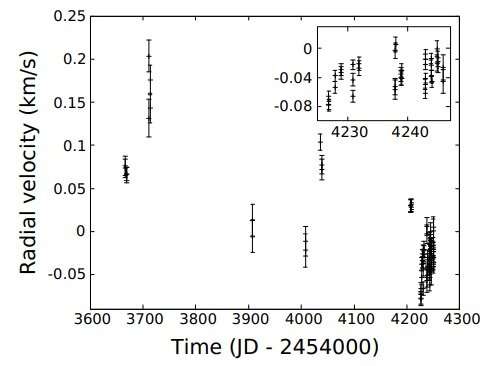June 18, 2019 report
Another brown dwarf in the system? Study investigates properties of HD 206893

Aiming to constrain the orbit and dynamical mass of the brown dwarf in the HD 206893 system, an international team of astronomers has investigated the host star and its companion using a combination of observing techniques. Results of this observational campaign suggest the presence of another massive object in the system, most likely a brown dwarf. The findings are detailed in a paper published June 7 on arXiv.org.
Brown dwarfs are intermediate objects between planets and stars. Astronomers generally agree that they are substellar objects occupying the mass range between 13 and 80 Jupiter masses. Although many brown dwarves have been detected to date, such objects existing as companions of other stars are a rare find.
One of these rare brown dwarf companions is HD 206893 B that was discovered about two years ago. It orbits HD 206893 – a nearby young star of spectral type F5V, located some 133 light years away. The host, estimated to be around 250 million years old, has a mass of about 1.32 solar masses and an effective temperature of approximately 6,500 K.
Given that brown dwarf companions are usually located at a relatively large distances from parent stars, their dynamical masses are extremely difficult to measure. This is the case with HD 206893 B as previous studies have found that it is separated from its host by about 11 AU, while leaving huge uncertainties regarding mass estimates. Based on evolutionary models and photometric data, it was estimated that its mass must lie somewhere between 12 and 50 Jupiter masses.
In order to constrain the mass of HD 206893 B more precisely and to gain more insights about its orbit, a group of astronomers led by Antoine Grandjean of Université Grenoble Alpes in France investigated the system using radial velocity (RV) data, direct imaging and astrometry.
"High-contrast imaging enables the determination of orbital parameters for substellar companions (planets, brown dwarfs) from the observed relative astrometry and the estimation of model and age-dependent masses from their observed magnitudes or spectra. Combining astrometric positions with radial velocity gives direct constraints on the orbit and on the dynamical masses of companions," the authors of the paper explained.
According to the study, results of the observations show a significant radial velocity drift over a period of about 1.6 years. Assuming that HD 206893 B is the source of this drift, it should have a dynamical mass between 60 and 720 Jupiter masses. This is inconsistent with previous observations, so the astronomers excluded this possibility.
Searching for other explanations of this phenomenon, the researchers noted that it could be caused by some other object yet undetected that is closer to the host than HD 206893 B. "An additional inner body that would contribute significantly to the observed RV drift and the tangential velocity in RA is needed. Its orbital period should be larger than our time baseline of 1.6 yr (1.4 AU)," the paper reads.
The researchers added that in order to trigger such RV drift, the potential companion should have a mass of about 15 Jupiter masses (brown dwarf), and should be located at a distance between 1.4 and 2.6 AU from the parent star.
The researchers estimate HD 206893 B has an orbital period between 21 and 33 years, and orbital inclination in the range from 21 to 40 degrees. Moreover, they noted that its dynamical mass could be even as low as 10 Jupiter masses if the system's age is lower than 50 million years, which cannot be excluded.
Hence, more radial velocity observations and direct imaging of the system are needed to confirm the presence of the inner object and to further constrain the parameters of both companions.
More information: Constraining the properties of HD 206893 B. A combination of radial velocity, direct imaging, and astrometry data, arXiv:1906.02058 [astro-ph.EP] arxiv.org/abs/1906.02058
Provided by Science X Network
© 2019 Science X Network




















